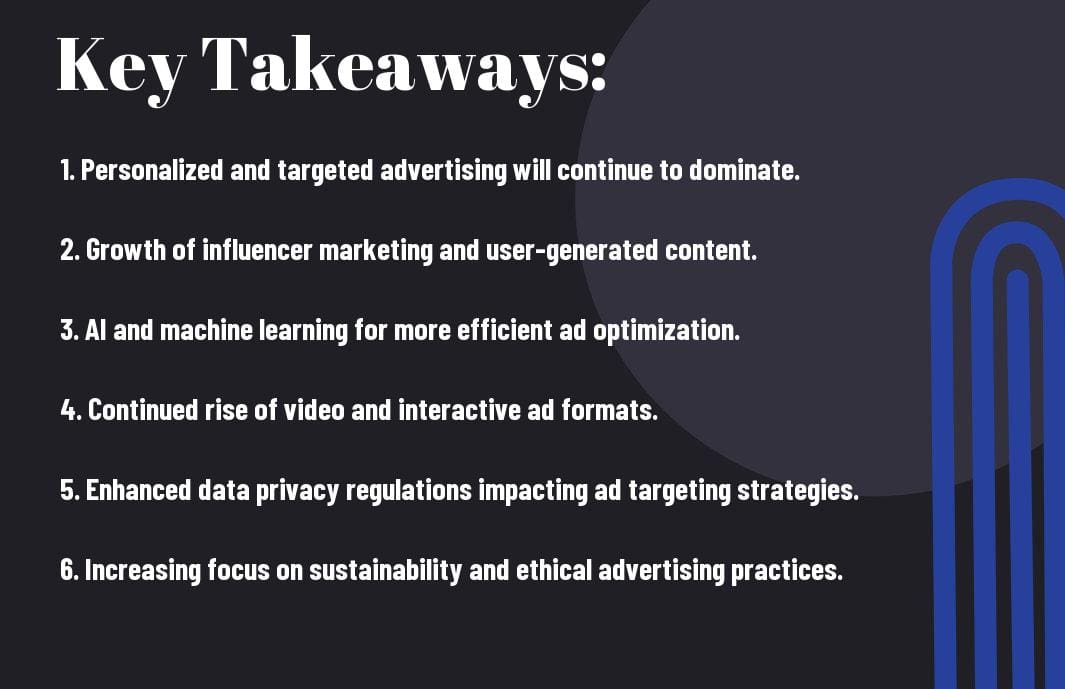Future advancements in online advertising are poised to reshape the digital marketing landscape in 2024. Keeping a finger on the pulse of emerging trends is crucial for businesses striving to stay ahead in this dynamic and competitive environment. As we approach the year 2024, it is imperative to anticipate the key developments that will influence how companies connect with their target audiences online.
To probe deeper into this topic, read the article on The Future of Digital Marketing: Trends to Watch in 2024.
Key Takeaways:
- AI & Automation: Artificial Intelligence and automation will continue to drive advancements in online advertising, enabling personalized targeting, dynamic ad content, and optimized campaign management.
- Privacy Regulations: Stricter privacy regulations and increasing consumer awareness around data protection will necessitate more transparent and ethical data usage practices by advertisers and platforms.
- Emerging Technologies: Innovations like augmented reality (AR), virtual reality (VR), and blockchain will reshape the online advertising landscape, offering new interactive and secure advertising opportunities.

The Shift Towards Programmatic Advertising
Even as we probe into 2024, the landscape of online advertising continues to transform rapidly. One of the key trends that have been shaping the industry is the shift towards programmatic advertising. This method involves the automated buying and selling of ad space in real-time, allowing for more targeted and efficient advertising campaigns.
The Rise of Real-Time Bidding
With the rise of programmatic advertising, real-time bidding (RTB) has gained significant momentum. RTB enables advertisers to bid on ad impressions instantly, ensuring that the right ad is shown to the right audience at the right time. This level of precision and targeting has revolutionized the way ads are served online, leading to higher engagement rates and better ROI for advertisers.
Advancements in Artificial Intelligence and Machine Learning
Learning from past data and predicting future trends accurately, artificial intelligence (AI) and machine learning (ML) have become integral components of programmatic advertising. AI algorithms can analyze massive amounts of data in real-time to optimize ad placements, while ML algorithms can continuously improve targeting and ad performance based on user interactions.
A crucial aspect of AI and ML in advertising is their ability to personalize ad experiences for users, making advertisements more relevant and engaging. However, there are privacy concerns surrounding the use of AI in ad targeting, as it collects and processes large amounts of user data. It is important for advertisers to be transparent with how they use AI and ML in their campaigns to maintain a balance between personalization and privacy.
The Influence of Privacy Regulations
The Impact of GDPR, CCPA, and Other Data Protection Laws
For online advertisers, the implementation of privacy regulations such as GDPR (General Data Protection Regulation) and CCPA (California Consumer Privacy Act) has been a game-changer. These laws have significantly altered the way data is collected, stored, and used for advertising purposes. Advertisers are now required to obtain explicit consent from users before collecting their data, leading to more transparent and ethical data practices across the industry.
Non-compliance with these regulations can result in hefty fines and damage to brand reputation. As a result, advertisers have had to revamp their data collection and processing practices to ensure compliance with these laws. While initial implementation may have been challenging, in the long term, these regulations have paved the way for a more trustworthy and sustainable online advertising ecosystem.
The Shift to First-Party Data Strategies
One of the most significant trends in online advertising due to privacy regulations is the shift towards first-party data strategies. With limitations on third-party data collection and tracking, advertisers are now focusing on building direct relationships with their audiences. By leveraging first-party data obtained directly from consumers, advertisers can create more personalized and targeted campaigns.
To meet the demands of personalized advertising while respecting user privacy, brands are investing in tools and technologies that allow them to collect, analyze, and utilize first-party data effectively. This shift not only ensures compliance with privacy regulations but also enables advertisers to deliver more relevant and engaging experiences to their target audiences.
The Emergence of New Advertising Platforms
Once again, the landscape of online advertising is evolving, with new platforms and technologies shaping the way brands connect with consumers. In the fast-paced digital world of 2024, advertisers are looking beyond traditional channels to reach their target audiences. The emergence of innovative advertising platforms is set to redefine the future of online advertising.
Rise of Connected TV (CTV) and Over-The-Top (OTT) Services
One of the major trends in online advertising is the rise of Connected TV (CTV) and Over-The-Top (OTT) services. With the increasing adoption of smart TVs and streaming devices, consumers are moving away from traditional cable TV and embracing these digital platforms for their entertainment needs. As a result, advertisers are shifting their focus towards CTV and OTT to reach a highly engaged audience. Brands are leveraging the targeting capabilities and interactive features offered by these platforms to deliver personalized and engaging ad experiences to viewers.
Advertising in Augmented Reality (AR) and Virtual Reality (VR)
An exciting development in the advertising space is the integration of Augmented Reality (AR) and Virtual Reality (VR) technologies. These immersive experiences allow brands to create interactive and engaging ad campaigns that provide a more personalized and memorable experience for consumers. As AR and VR continue to gain popularity, advertisers are exploring new ways to incorporate these technologies into their marketing strategies to stand out in a crowded digital landscape.
Rise of AR and VR advertising opens up a world of possibilities for brands to connect with their target audience in a more impactful way, blurring the lines between the physical and digital realms.
Changes in Social Media Advertising
The Proliferation of Short-Format Video Content
Despite the ever-evolving landscape of social media advertising, one trend that continues to gain momentum is the proliferation of short-format video content. Platforms like TikTok and Instagram Reels have transformed the way users consume content, leading to a significant shift in advertising strategies. Marketers are increasingly leveraging these platforms to create engaging and memorable video ads that capture the attention of users in a matter of seconds.
The Integration of E-commerce and Social Platforms
To adapt to changing consumer behavior and preferences, social media platforms are now focusing on the integration of e-commerce directly within their apps. This seamless integration allows users to discover and purchase products without ever leaving the platform, creating a frictionless shopping experience. Marketers are taking advantage of these features to drive direct sales and track ROI more effectively.
Social commerce is poised to revolutionize the way brands interact with consumers on social media. By combining the power of social platforms with e-commerce capabilities, marketers can create a seamless shopping experience that blurs the lines between advertising and online retail. This integration not only streamlines the path to purchase for consumers but also provides brands with valuable insights into consumer behavior and preferences.
The Use of Advanced Analytics and Measurement
Now, let’s probe into the exciting world of advanced analytics and measurement in online advertising. In this chapter, we will explore how cutting-edge technologies are revolutionizing the way advertisers target audiences and measure the effectiveness of their campaigns.
- Predictive Analytics in Audience Targeting
Traditional Audience Targeting Predictive Analytics in Audience Targeting Relies on historical data and demographics Uses machine learning algorithms to predict future behaviors May not be able to accurately target specific audiences Enables precise targeting based on real-time insights Audience Predictive Analytics in Audience Targeting
Audience targeting has evolved from basic demographic data to predictive analytics, allowing advertisers to leverage machine learning algorithms that predict consumer behavior. By analyzing vast amounts of data in real-time, advertisers can target audiences with unprecedented accuracy and relevance.
- Improved Attribution Models and Multi-Touch Attribution
Traditional Attribution Models Improved Attribution Models and Multi-Touch Attribution Single touchpoint attribution Attributes conversions to multiple touchpoints May not accurately reflect customer journey Provides a holistic view of the customer journey Advanced Improved Attribution Models and Multi-Touch Attribution
With the rise of multiple digital touchpoints, advanced attribution models are important for understanding the full customer journey. Improved attribution models and multi-touch attribution offer advertisers a comprehensive view of how different channels contribute to conversions, helping them optimize their marketing strategies effectively.
Ethical Advertising and Brand Responsibility
Addressing Ad Fraud and Maintaining Transparency
Your online advertising efforts must prioritize authenticity and transparency in the face of an increasingly complex digital landscape. Ad fraud continues to be a significant challenge, threatening the integrity of online marketing campaigns. To combat this, invest in advanced fraud detection tools and work closely with legitimate publishers to ensure your ads are reaching real audiences. Transparency is key, so regularly monitor and analyze your ad performance to detect any suspicious activities. By taking proactive measures, you can safeguard your brand’s reputation and budget.
Social Impact and Sustainable Advertising
Sustainable advertising goes beyond just promoting products and services; it involves aligning your brand with social causes and environmental responsibility. By incorporating corporate social responsibility into your advertising strategies, you not only engage socially conscious consumers but also contribute to a positive impact on society. Consumers today expect brands to demonstrate ethical practices and show dedication to sustainability. Embrace this shift by supporting initiatives that make a difference in the community and highlight your efforts in your marketing campaigns.
Advertising with a social impact can help foster long-term customer loyalty and differentiate your brand in a competitive market. Consumers are increasingly drawn to companies that prioritize sustainability and social responsibility, making it imperative for brands to embrace ethical advertising practices. By integrating sustainability into your brand messaging and operations, you can not only attract new customers but also build a positive brand image that resonates with today’s socially conscious audience.
Preparing for the Cookie-less Future
Development in Contextual Advertising
Noticing the impending changes in online advertising regulations, companies are shifting their focus towards contextual advertising to reach their target audiences effectively. Contextual advertising is the practice of displaying ads based on the content of the web page being viewed rather than the user’s browsing history. This strategy allows advertisers to present relevant ads to users without relying on third-party cookies, ensuring compliance with privacy regulations and delivering a more personalized experience for consumers.
Adoption of Universal Identifiers and Alternative Tracking Solutions
Universal identifiers and alternative tracking solutions are gaining traction as the industry prepares for a cookie-less future. Universal identifiers offer a standardized way to track users across the web, providing advertisers with valuable data for targeting and measurement purposes. This approach aims to establish a more transparent and privacy-conscious advertising ecosystem that prioritizes user consent and data protection.
Alternative tracking solutions encompass a variety of techniques, such as first-party data collection and server-to-server communication, which allow advertisers to continue delivering relevant and targeted ads in the absence of third-party cookies. By diversifying their tracking methods, businesses can adapt to the evolving digital landscape and maintain their marketing effectiveness without compromising user privacy.
Final Words
So, as we look ahead to the future of online advertising in 2024, it is clear that the industry is poised for significant advancements and changes. With the continued growth of AI and machine learning technologies, we can expect to see more personalized and targeted advertising experiences for consumers. Additionally, as privacy concerns continue to take center stage, we anticipate stricter regulations and a shift towards more transparent and ethical advertising practices.
In this rapidly evolving landscape, it will be crucial for businesses to stay abreast of emerging trends and leverage innovative strategies to effectively engage with their target audiences. By embracing these changes and adapting to the evolving digital ecosystem, companies can position themselves for success and stay ahead in the competitive online advertising market.
FAQ
Q: What are the key trends to watch in online advertising in 2024?
A: The key trends to watch in online advertising in 2024 include personalization, artificial intelligence, voice search, video advertising, influencer marketing, customer privacy, and augmented reality.
Q: How is personalization shaping the future of online advertising?
A: Personalization is transforming online advertising by allowing brands to create targeted and customized ads that resonate with individual users, leading to higher engagement and conversion rates.
Q: What role does artificial intelligence play in the future of online advertising?
A: Artificial intelligence is revolutionizing online advertising by enabling advanced targeting, dynamic ad creation, real-time optimization, and predictive analytics, resulting in more effective and efficient ad campaigns.
Q: How is voice search impacting online advertising trends?
A: Voice search is changing online advertising by requiring brands to optimize their content for voice queries, create audio ads, and explore new ways to reach users through voice-activated devices and assistants.
Q: Why is video advertising becoming increasingly important in online advertising?
A: Video advertising is gaining prominence in online advertising due to its ability to capture attention, convey messages effectively, and drive engagement, making it a crucial component of digital marketing strategies.
Q: How is influencer marketing evolving in the online advertising landscape?
A: Influencer marketing is evolving by becoming more data-driven, transparent, and regulated, with brands partnering with micro and nano-influencers, focusing on authenticity, and measuring the impact of influencer campaigns more effectively.
Q: What is the significance of customer privacy in the future of online advertising?
A: Customer privacy is paramount in online advertising, with regulations like GDPR and CCPA shaping how brands collect, store, and use consumer data, leading to greater emphasis on transparency, consent, and data protection in advertising practices.
Q: How is augmented reality (AR) shaping the future of online advertising?
A: Augmented reality is revolutionizing online advertising by enabling immersive, interactive ad experiences that allow users to visualize products, try virtual try-ons, and engage with brands in innovative ways, enhancing the overall effectiveness of advertising campaigns.




